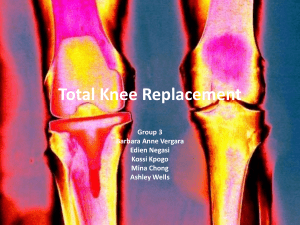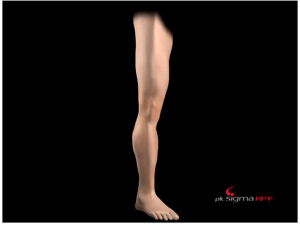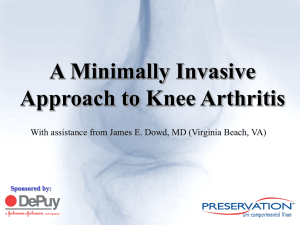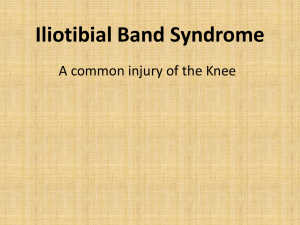Oxford® Partial Knee
advertisement
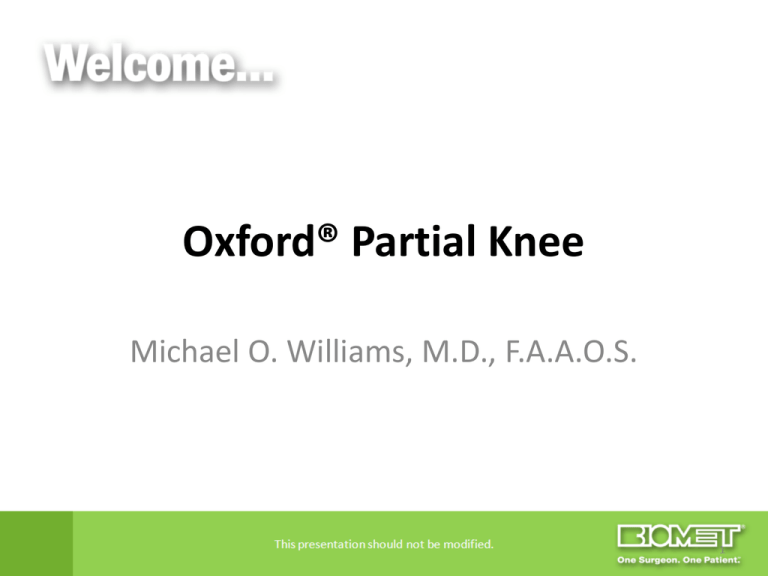
Oxford® Partial Knee Michael O. Williams, M.D., F.A.A.O.S. Oxford Partial Knee Replacement The Oxford partial knee replacement is indicated for treatment of anteromedial osteoarthritis of the knee. This arthritis involves primarily the medial compartment of the knee with joint space narrowing seen on X-rays. The lateral compartment and patella are usually not arthritic in this condition. The Oxford differs from other partial knees in that it has a mobile UHMWPE bearing which duplicates normal knee kinematics. Arthritis • Defined as inflammation of the joint • Number one cause of disability in the United States1 • More than 100 different types • Two primary types – Rheumatoid – Osteoarthritis Rheumatoid Arthritis • • • • • Inflammatory Diagnosed at younger ages than osteoarthritis Can affect multiple joints at one time Excess synovial fluid Cartilage destruction Osteoarthritis • • • • Degenerative joint disease Most common form of arthritis Wear and tear condition Develops over time – Overuse, injury or repetitive movement – Developmental disorders • Results in pain, stiffness Symptoms of Osteoarthritis2 • Pain • Stiffness • Grating or “catching” sensation during joint movement • Bony growths at the margins of affected joints X-Rays • Helps determine severity of joint damage • Cannot see cartilage on an X-ray • Space on normal X-ray is healthy cartilage Healthy X-ray • Space shows healthy cartilage Osteoarthritis X-ray • Joint space narrowing • Abnormal bone formation – “spurs” • Joint deformity – Bowleg – Knock-knee • A manageable, treatable condition When to Consider Joint Replacement • Conservative non-operative treatments fail to provide adequate pain relief • Diminished quality of life • Diminished joint function Joint Replacement • Also called “arthroplasty” • Implants to resurface damaged bone and cartilage • Metal alloy and durable plastic • Traditional vs. min. invasive with Oxford® Partial Knee Traditional Total Knee Replacement • Resurfaces damaged cartilage on: – End of femur – Top of tibia – Back of patella • Incision between six and eight inches long Primary Knee Components Femoral Component Polyethylene Bearing Tibial Tray Minimally Invasive Knee Replacement • Potential advantages to traditional knee replacement – Healthy muscles and tissues preserved • May be through a shorter incision – Less blood loss – Less tissue damage • Not all patients are candidates Minimally Invasive vs. Traditional Incisions Minimally Invasive Incision Traditional Incision Minimally Invasive Partial Knee Replacement • Replaces one compartment of the knee • Knee cartilage resurfaced – Metal alloy and polyethylene (plastic) components • Instrumentation for minimally invasive technique to help preserve healthy tissue Oxford Partial Knee Components Femoral Component Polyethylene Bearing Tibial Tray Oxford® Partial Knee Animation Oxford® Partial Knee Implant • Only mobile-bearing partial knee in U.S. – Mobile plastic bearing moves with knee motions – Mobile bearing helps limit forces to help avoid loosening4,5 • One clinical study yielded a 94% success rate at 10 years and an 89% success rate at 20 years6 • There is no specific expected survivorship for joint replacement • • • • • • • • Examples of Potential Complications of Total Joint Replacement, Any of Which Can Lead to Revision Surgery Infection Blood clots Implant breakage Malalignment Wear Loosening Dislocation No implant will last forever Complications Affecting Outcome & Longevity • Malalignment of implants - Very dependent on surgical technique and surgeon’s skill level - Can be prevented with Signature cutting blocks and guides Signature ™ Personalized Patient Care Signature ™ System • Patient-specific femoral and tibial positioning guides (not implanted) used for instrument placement to remove damaged bone and cartilage • Developed from MRI Scan • Allows for personalized instrumentation for implant positioning Before Surgery • Traditional – X-rays to plan implant size • Signature™ System – MRI Scan to plan surgery • Digital, interactive planning software – Plans implant size and placement before surgery Pre-op MRI/CT Scan • About 20 minutes for MRI scan • Scan of hip, knee and ankle • Head stays outside of machine MRI The Surgical Procedure • Signature – Patient-specific Guides • • • • Unique to every patient Placed directly on bone/cartilage Position pins for cut blocks Cut blocks guide removal of damaged bone and cartilage Surgical Instrumentation Traditional Signature™ System Signature™ System Benefits • Does not invade the bone canal • Fewer surgical instruments than traditional partial knee replacement • Allows for personalized instrumentation for placement of the Oxford® Partial Knee implant • Reduces the incidence of malaligned components do to surgeon error • Implant alignment optimized for that patient Value of Joint Replacement • Total joint replacement can save an individual as much as $68,000 (total knee replacement) to $180,000 (total hip replacement) in medical costs over the life of the average total joint recipient as compared to non‐surgical treatment.4,5 Success of Total Joint Replacement • Every year, over 1,000,000 people in the United States have joint replacement • Joint replacement treats debilitating pain and deformity from various forms of arthritis Closing • A proper diagnosis from an orthopedic surgeon can help identify cause of joint pain • Many conservative treatments available • Arthritis can be treated • New surgical treatments also now available with joint replacement implants with improved function and longevity References 1. 2. 3. 4. 5. 6. 7. 8. Centers for Disease Control and Prevention http://www.cdc.gov/chronicdisease/resources/publications/AAG/arthritis.htm The Arthritis Foundation http://www.arthritis.org/rheumatoid-arthritis.php Vanguard Complete Knee System Package Insert http://www.biomet.com/orthopedics/getFile.cfm?id=2171&rt=inline Argenson, J. et al. Polyethylene Wear in Meniscal Knee Replacement. A One to Nine-year Retrieval Analysis of the Oxford Knee. Journal of Bone and Joint Surgery [Br]. 74 B:228–32, 1992. Psychoyios, V. et al. Wear of Congruent Meniscal Bearings in Unicompartmental Knee Arthroplasty—A Retrieval Study of 16 Specimens. Journal of Bone and Joint Surgery [Br]. 80-B:976–82,1998. Price, A. and Svard, U. A Second Decade Lifetable Survival Analysis of the Oxford Unicompartmental Knee Arthroplasty. Clinical Orthopaedics and Related Research. Published Online 13 August 2010 AAOS. http://orthoinfo.aaos.org/topic.cfm?topic=A00233 Chang RW, Pellissier, JM, Hazen GB, “A Cost‐effective Analysis of Total Hip Arthroplasty for Osteoarthritis of the Hip,” Journal of the American Medical Association (JAMA), Vol. 275, No.11, 1996, pp. 858‐865. (Figures apply to average 60 year old patient and adjusted for inflation.) Questions Thank You
